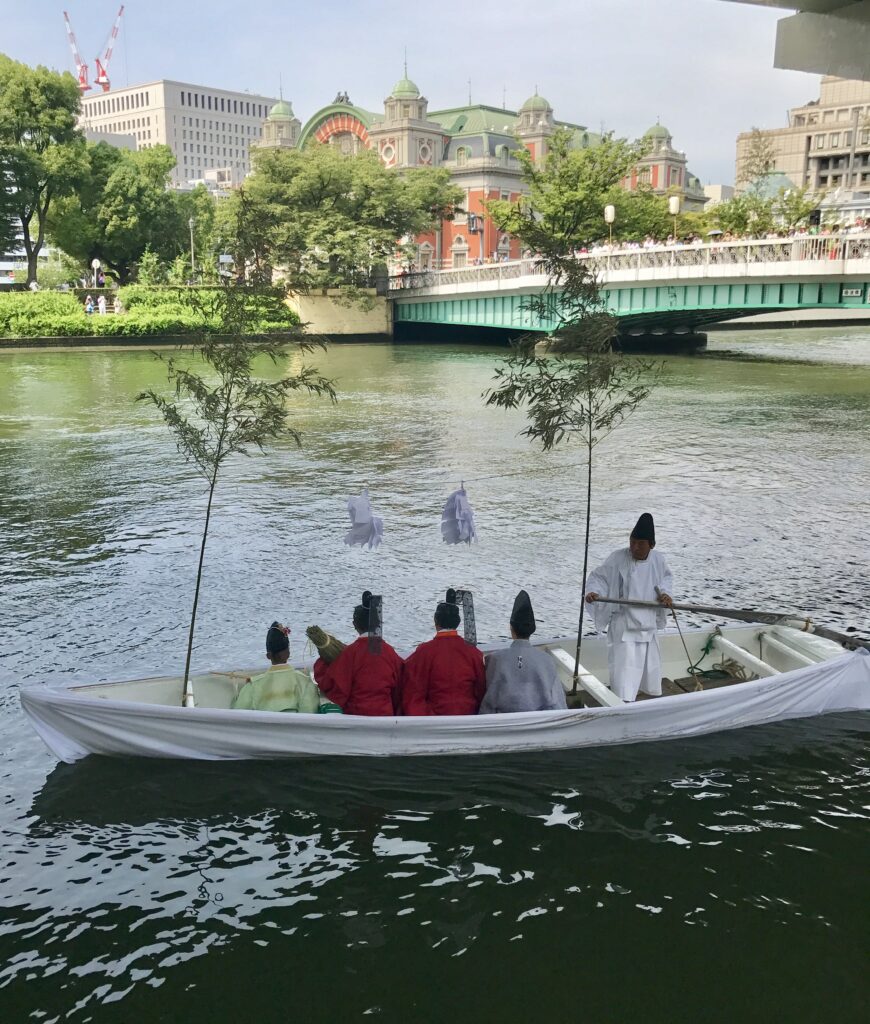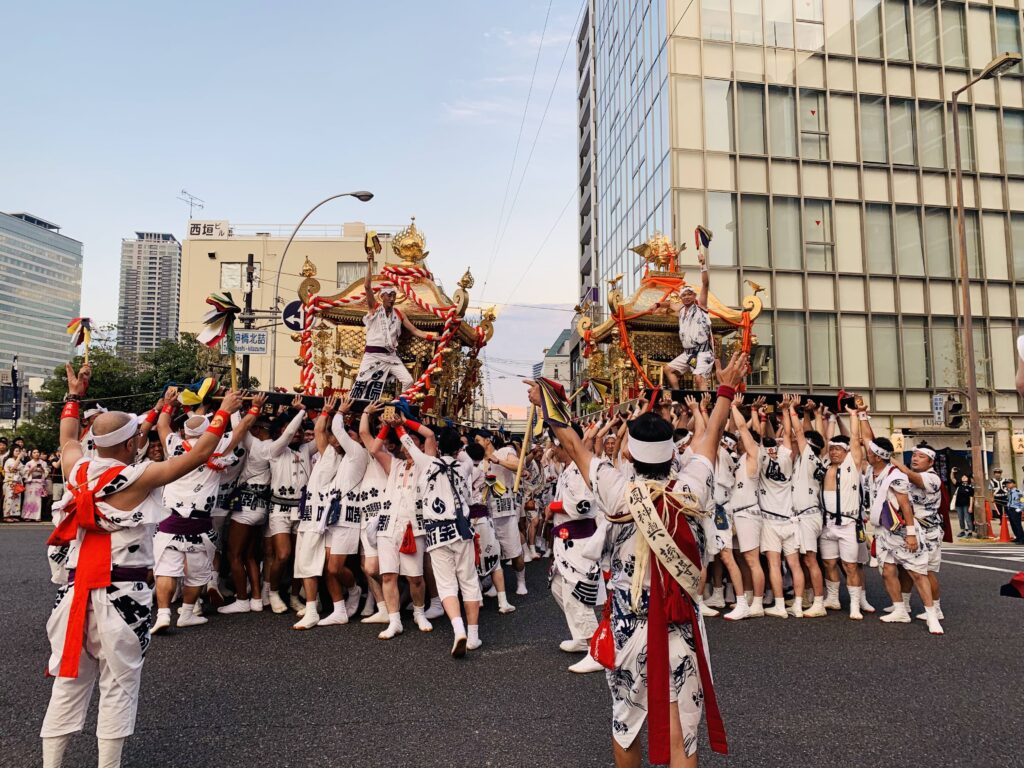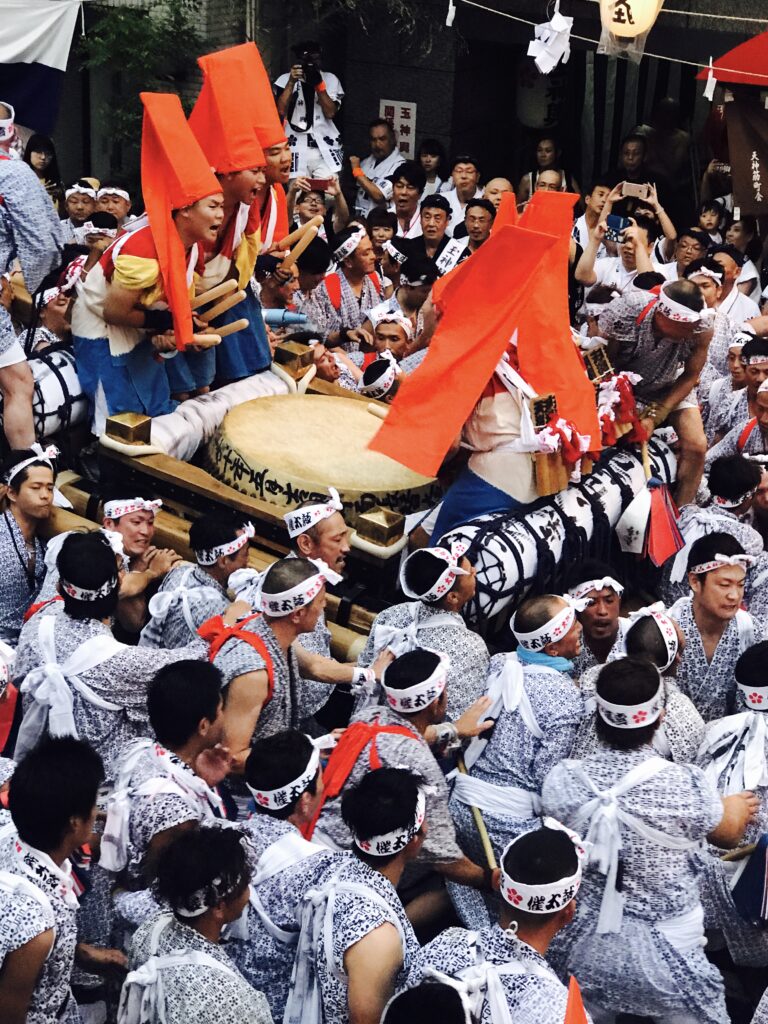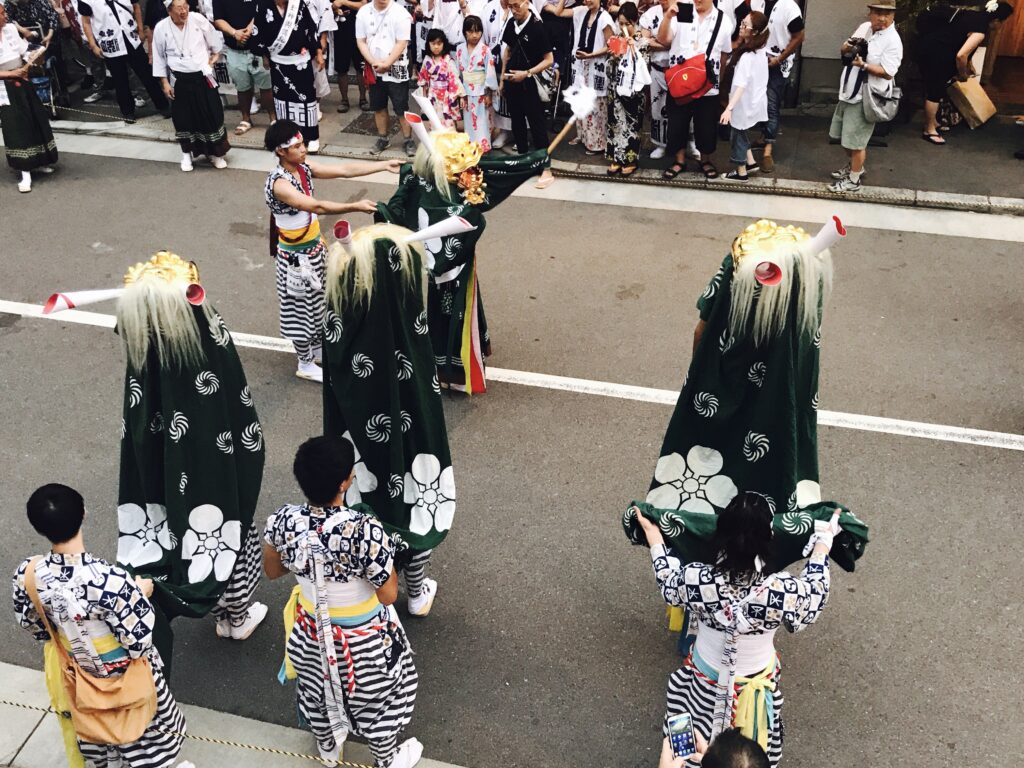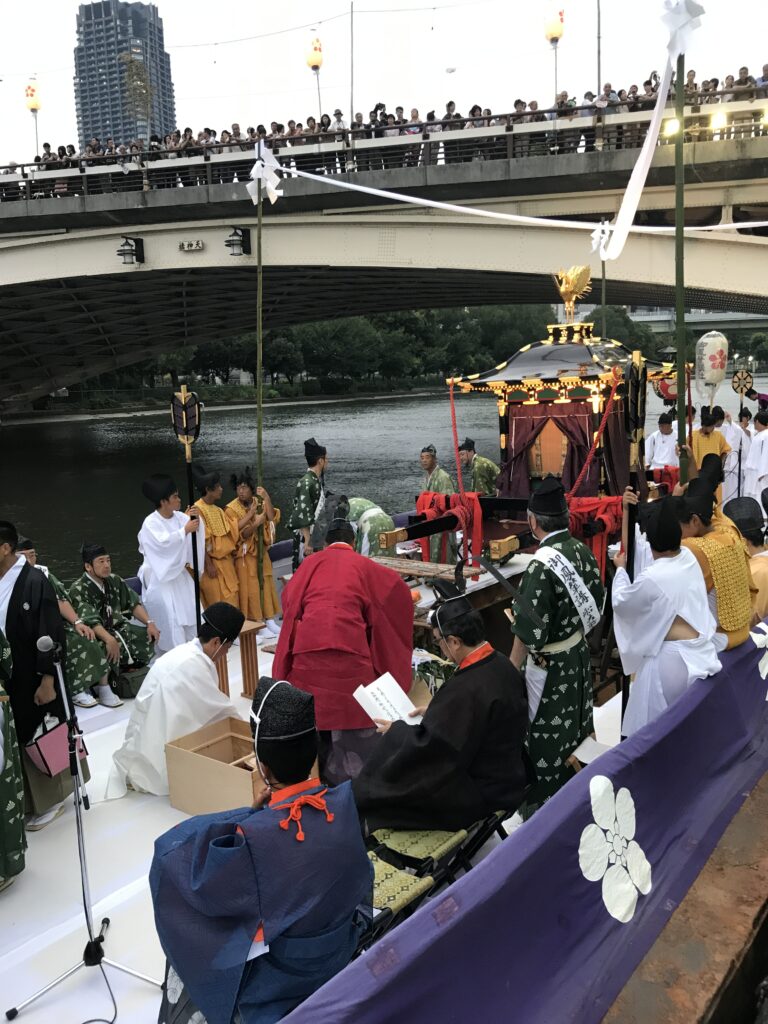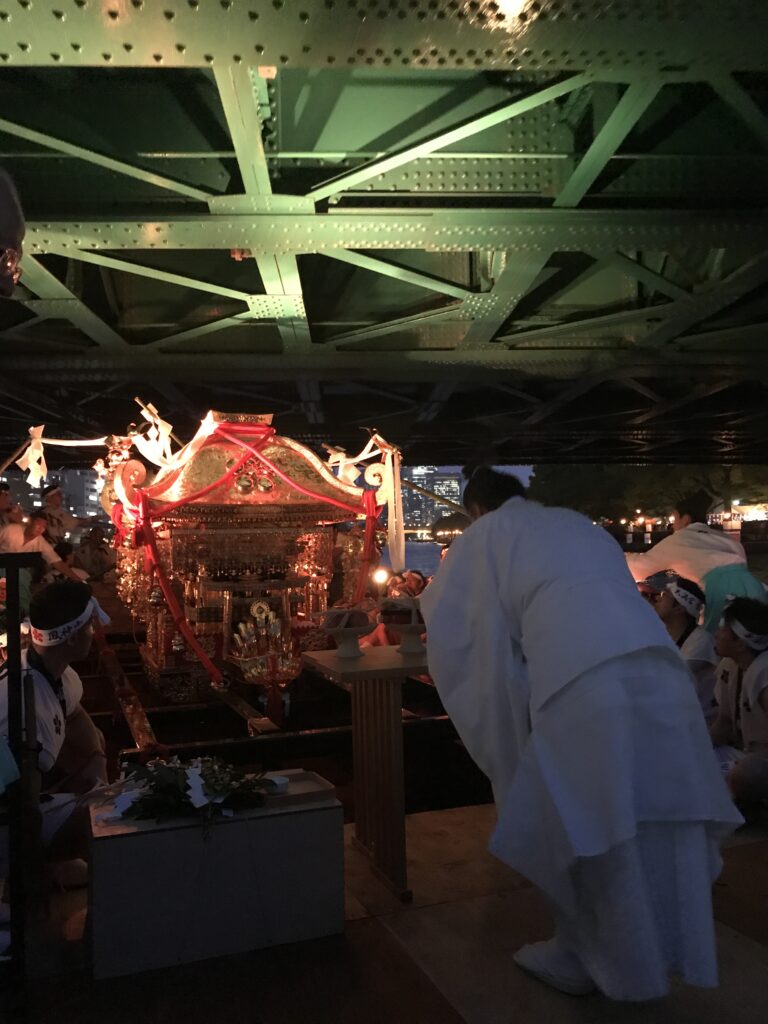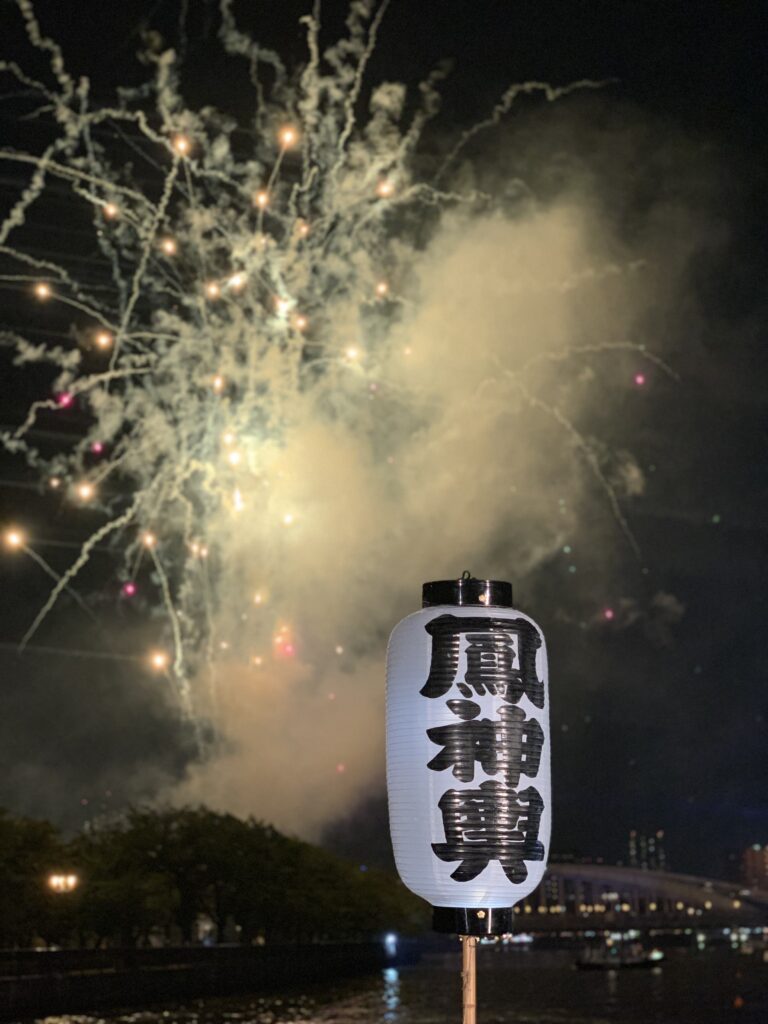Tenjin Matsuri. Myth and Ritual
Tenjin Matsuri is an extravaganza of sound, movement, light and color dedicated to the god Tenjin: fireworks to appease the god of thunder, and the sweat of the commoners to pacify the ghost of an aristocrat scholar Sugawara no Michizane, the central character of this millennium-old set of rituals and practices, is a historically attested character, a scholar who lived at the end of the 9th century, became a close advisor of Emperor Daigo, and was unjustly exiled to Dazaifu (Kyushu) as a result of the slander of one of his political rivals, Fujiwara no Tokihira. After his death in 903, Kyoto was plagued by epidemics and droughts, Tokihira and another member of his family died of disease in 909, while Michizane’s successor suffered a violent death in 913. Moreover, in 930 the Imperial Palace precincts were struck by lightning, which caused a fire in which members of the Fujiwara family lost their lives. Emperor Daigo himself died of the shock and the society plunged into chaos (Fukuta 2000)
These recorded historical facts created rumors that all the above- mentioned unfortunate incidents were caused by Michizane’s vengeful ghost, and in 942 a shamaness claimed that she was possessed by “the deceased Sugawara’s spirit … [and] that these disasters had been willed by him. In 955 an inspired young child of a Shinto priest also announced the same divine message and proclaimed that the spirit of Sugawara had become the deity of disasters and a chief deity of the thunder demons. The imperial court, surprised by these divine messages and the public rumor, enrolled his angry spirit among the deities and dedicated to him a shrine, named the Kitano-jinja, Kyoto.” (Hori 1974) The phenomenon that took place here is called hitogami, a person who becomes/ is turned into a god because there is strong belief that it possesses powers (be they destructive or creative) that can be harnessed for the welfare of humanity. We thus have quite accurate records of how a myth was created, that of the powerful Sugawara no Michizane, who was initially enshrined as a God of Thunder (the episode with the storm that ravaged the Imperial Palace being one of the most remarkable), and later associated with the God Tenjin-an association that has continued until today.
When it comes to the connection between myth and ritual, things are often ambiguous, and it is usually hard to determine which came first, whether the story represents the scaffold onto which the gestures were added, or whether a certain practice was later associated, for various reasons, with a tale about the deeds of extraordinary beings. Mircea Eliade, for example, sees myth as “the archetypal model for all ‘creation’”, something that “functions as a model and justification for all human action3” (1992). Within this theoretical framework “beliefs, creeds, symbols, and myths” are seen as “conceptual blueprints: they direct, inspire, or promote activity, but they themselves are not activities” (Bell 2009). These approaches, however, have become slightly obsolete, being focused on a metaphorical analysis of patterns of thought and behavior (similar to Jung’s idea of a collective subconscious), while more recent studies seem to regard ritual as preceding myth in many cases. The ritual studies expert Ronald Grimes is of this opinion, emphasizing the fact that “historically considered, the religious consciousness emerges in a sequence: ritual, myth, then drama. Myth and ritual are ‘spatially’ parallel, but ritual is temporally prior” (1995: 143).
The center of Tenjin Matsuri is the shrine Osaka Tenmangu, which, according to the shrine records, was built around an older place of worship, Dai Shôgun Sha, dating from the year 650. The legend says that on his way to exile, Michizane stopped at Dai Shôgun Sha to pray for a safe journey. Almost fifty years later, in 949, seven pine trees appeared overnight in front of the shrine, emitting a strange light in the dark. Hearing of the miracle, Emperor Murakami ordered another shrine, dedicated to Michizane/ god Tenjin to be built there. The shrine was completed in 950, and in 951 Tenjin Matsuri took place for the first time5. Nowadays Tenjin Matsuri is a vast enterprise, with thousands of active participants and elaborate events organized on July 24th (Yomiya, the eve of the festival) and July 25th (Honmiya, the main day), but originally it was conducted as a summer purification festival. Shôji Kurahayashi mentions it only by the name of Tenma no misogi (the Tenma purification), and, although he includes it among the three famous Japanese festivals, he makes no reference to Michizane or the god Tenjin (Kurahayashi 1983)
Kunio Yanagita connects such practices to offerings made to the deities of water-agricultural practices that fall under the category of fertility rites, and are meant to pacify the gods that can affect the crops (1974). This association is not far-fetched, as initially Tenma no misogi was conducted by the Edo river, now known as Ôgawa (the “big river”).
One other element that must be taken into consideration here is the god Tenjin-Sugawara no Michizane came to be associated with this particular deity, but beliefs in the god Tenjin were common in Japan even before the inauspicious events of the 10th century. Kôji Takashima sees the Tenjin set of beliefs as a kami-buddha combinatory practice6, an example of religious syncretism where imported elements and indigenous beliefs were combined (2016). We thus have three main threads that represent the origin of Tenjin Matsuri: a historical figure who suffers a miraculous transformation and the ritual to appease his vengeful ghost, a purification/ fertility ritual performed near bodies of water (rivers, in the case of Osaka), and popular beliefs in the god Tenjin, a deity known to respond positively to all kinds of prayers. In the 21st century, Sugawara no Michizane is regarded as the central figure of Tenjin Matsuri, familiarly addressed by the locals as either Tenjin-san, or Lord Michizane (slightly more formal). Due to spatial and temporal proximity, Gion Matsuri and Tenjin Matsuri (Kyoto and Osaka, both taking place in July) are often compared, but my own field observations have led me to believe that there is a greater degree of intimacy between the participants in Tenjin Matsuri and their local deity than it is the case with their Gion counterparts. As one of my informants stated, Lord Michizane is something like a local ojisan (“uncle”, “mature man”) who has come to visit the area and spend some time with the people he cares for. One explanation for this phenomenon may reside in the fact that religious syncretism is even more obvious in the case of Gion Matsuri, where several distinct deities are celebrated (Susano-wo at Yasaka Shrine, the Goddess Kannon in the Minami Kannon district, and the list can continue), as opposed to Tenjin Matsuri, where the assimilation of beliefs was more intense and resulted in a linear evolution towards the contemporary rituals.
Ronald Grimes states that “we become actors [in a ritual] in the moment we mythologize our myths” (1995: 143), and this becomes a significant theoretical construct if we consider the current social background of Tenjin Matsuri. Researchers may focus on its historical, religious, and literary origin and development, but the participants have absorbed the linear, unequivocal myth adopted by the religious center of the festival, and thus both the myth and the ritual exist on parallel planes in contemporary society, with no regard for historical chronology.

